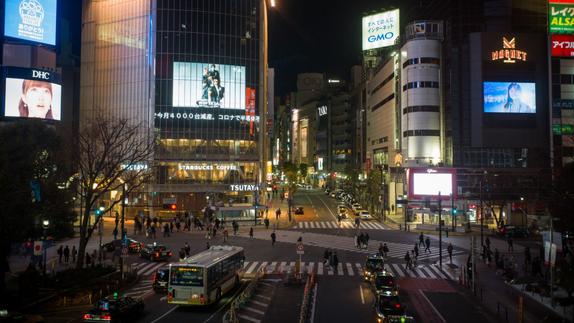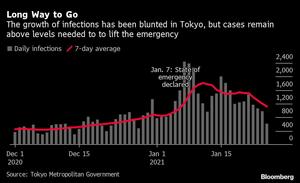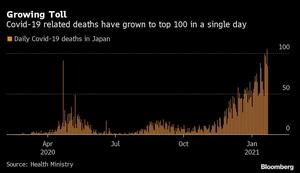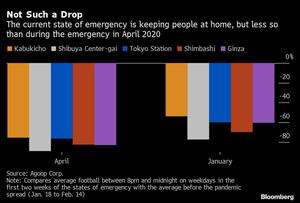 Pedestrians cross an intersection in the Shibuya district of Tokyo, Japan, on Friday, Jan 8, 2021. (KENTARO TAKAHASHI / BLOOMBERG)
Pedestrians cross an intersection in the Shibuya district of Tokyo, Japan, on Friday, Jan 8, 2021. (KENTARO TAKAHASHI / BLOOMBERG)
Japan is halfway through its second state of emergency, with officials set to examine the effectiveness of the measure this week.
Experts will look to determine if the country can quickly return to normal like it did following a similar emergency last spring, or risk being dragged into a lengthy and punishing battle against the coronavirus.
Prime Minister Yoshihide Suga declared the emergency for Tokyo and adjacent areas on Jan 7, with residents requested to avoid going out after 8 pm and bars and restaurants to be instructed to close at that time, to address an alarming surge in cases. While the areas under the emergency that is set to run until Feb 7 have already been expanded once, there are chances it may be extended, and the areas under its purview could be broadened yet again.
Prime Minister Yoshihide Suga declared the emergency for Tokyo and adjacent areas on Jan 7, with residents requested to avoid going out after 8 pm and bars and restaurants to be instructed to close at that time, to address an alarming surge in cases
While declaring the emergency earlier this month, Suga indicated it would take two weeks for the effects to show up in daily infection numbers. With that mark passed on Friday, there were indications that the growth seen in new infections appears to have at least been blunted. Tokyo saw its lowest case numbers in almost a month on Monday, reporting 618 infections.
ALSO READ: Japanese PM faces mounting pressure over pandemic response
Hitoshi Oshitani, a professor of virology at Tohoku University and a leading member of a panel advising the government, says Japan’s experts will look at the level before Christmas as a benchmark to determine the impact of the measures taken.
“I’m not sure if we’ll still see some increasing trend or stability or a decreasing trend in the number,” he told Bloomberg News on Friday. “We need to wait until mid-next week to see the trend.”
The possibility of an extension is being discussed, with a decision likely to be based on this week’s figures, according to an FNN report on Friday that cited unidentified officials. Any extension would likely be for another month, the report said.
Broader Restrictions
Public health experts had already cast doubt on whether a monthlong measure would be enough -- especially given that the first emergency, which called for broader restrictions and was imposed when daily cases were at a much lower level, itself went on for six weeks.
Virus czar Yasutoshi Nishimura is among officials who have bemoaned the fact that the second state of emergency hasn’t had the same impact as the first on people’s movement, with calls for restrictions considerably lighter this time. The current area could be further expanded, depending on infections, he said on Jan 14.

Streets that were deserted during the April emergency now still see crowds, with policies encouraging people to stay home as much as possible, but also keeping department stores, bars and restaurants open for most of the day. The second emergency has led to a decline in footfall, particularly after 8 pm, but the drop is less than that seen in the first emergency.
The government’s domestic travel initiative remains on hold during the emergency. A report published last week in the Journal of Clinical Medicine said the GoTo travel initiative may have contributed to increasing COVID-19 cases. The report was written by Kyoto University researchers Asami Anzai and Hiroshi Nishiura, who advised on a government virus task force.
ALSO READ: Tokyo organizers vow to stage Olympics amid increased doubts
While officials are also encouraging remote work, the impact remains well off the goal. Tokyo Governor Yuriko Koike said on Friday that 57.1 percent of companies had implemented a remote work policy, citing the results of a survey, up from 51.4 percent in December.

An additional worry this time is the growing number of people requiring hospitalization. With daily cases in the thousands, hospitals that are treating coronavirus patients are increasingly stretched, with available beds and the state of the medical system among factors the government will examine when determining to lift the emergency. Serious cases have tripled since mid-November to top 1,000 for the first time.
Adding to that concern is the fact that since the start of the new year, the proportion of those aged 65 or above -- most at risk of death from COVID-19 -- has begun to grow.
READ MORE: Japan's virus toll tops 5,000, new cases in capital slow down
That’s contributing to a rising death toll. While Japan escaped the worst of the pandemic -- to such an extent that overall deaths fell in 2020 for the first time in a decade -- as winter has set in, the numbers have been consistently growing, topping 100 in recent days. On Saturday, that took the total toll of the pandemic in the country past 5,000.



